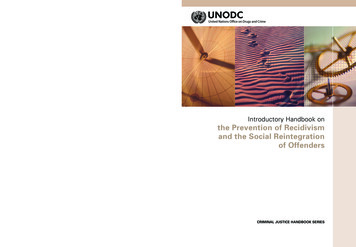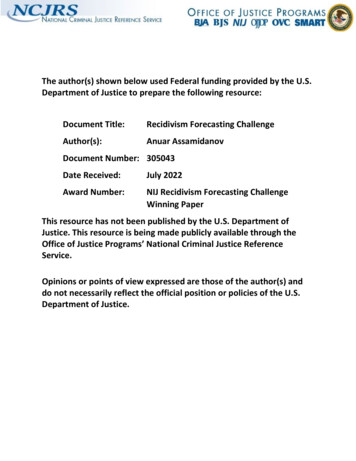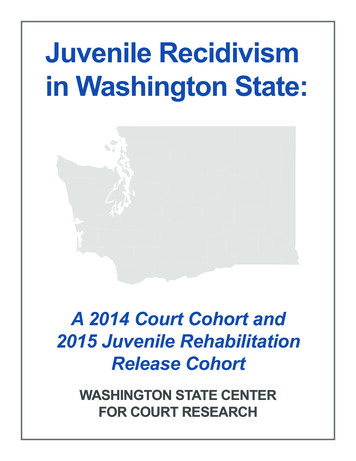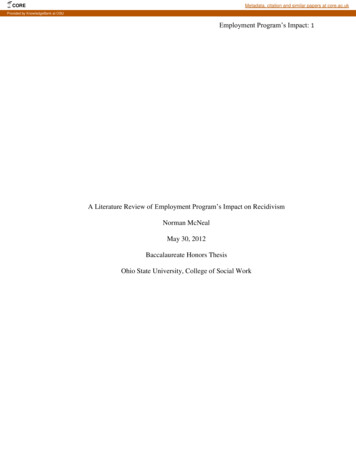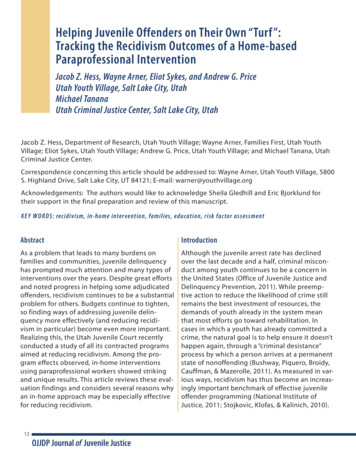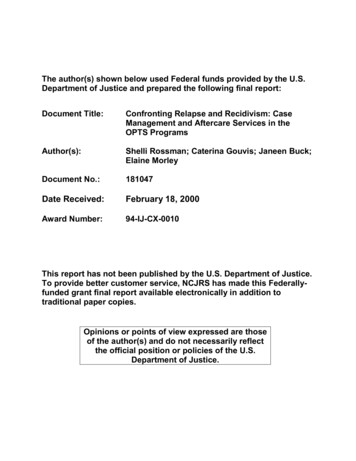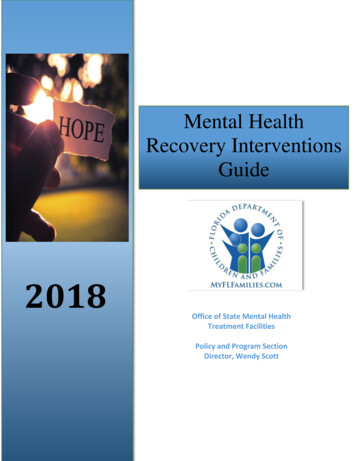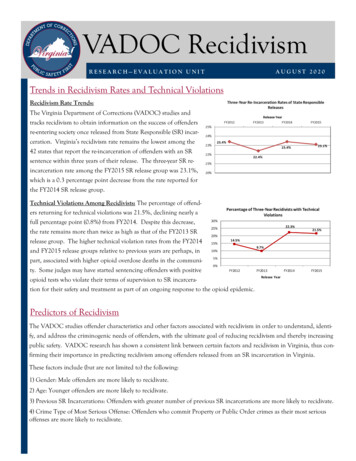
Transcription
VADOC RecidivismRESEARCH—EVALUATION UNITAUGUST 2020Trends in Recidivism Rates and Technical ViolationsRecidivism Rate Trends:The Virginia Department of Corrections (VADOC) studies andtracks recidivism to obtain information on the success of offendersre-entering society once released from State Responsible (SR) incarceration. Virginia’s recidivism rate remains the lowest among the42 states that report the re-incarceration of offenders with an SRsentence within three years of their release. The three-year SR reincarceration rate among the FY2015 SR release group was 23.1%,which is a 0.3 percentage point decrease from the rate reported forthe FY2014 SR release group.Technical Violations Among Recidivists: The percentage of offenders returning for technical violations was 21.5%, declining nearly afull percentage point (0.8%) from FY2014. Despite this decrease,the rate remains more than twice as high as that of the FY2013 SRrelease group. The higher technical violation rates from the FY2014and FY2015 release groups relative to previous years are perhaps, inpart, associated with higher opioid overdose deaths in the community. Some judges may have started sentencing offenders with positiveopioid tests who violate their terms of supervision to SR incarceration for their safety and treatment as part of an ongoing response to the opioid epidemic.Predictors of RecidivismThe VADOC studies offender characteristics and other factors associated with recidivism in order to understand, identify, and address the criminogenic needs of offenders, with the ultimate goal of reducing recidivism and thereby increasingpublic safety. VADOC research has shown a consistent link between certain factors and recidivism in Virginia, thus confirming their importance in predicting recidivism among offenders released from an SR incarceration in Virginia.These factors include (but are not limited to) the following:1) Gender: Male offenders are more likely to recidivate.2) Age: Younger offenders are more likely to recidivate.3) Previous SR Incarcerations: Offenders with greater number of previous SR incarcerations are more likely to recidivate.4) Crime Type of Most Serious Offense: Offenders who commit Property or Public Order crimes as their most seriousoffenses are more likely to recidivate.
Current AnalysesIn addition to the common predictors, VADOC has also found other predictors of recidivism that will be highlighted inthis report. In particular, there is an increased awareness of the role played by drug use in recidivism. The relation of thefollowing factors with recidivism, alongside other known predictors of recidivism, will be explored in this report:1) Location of SR Incarceration: Offenders who serve their entire SR incarceration in a Local/Regional Jail are more likelyto recidivate than those who went into a VADOC Facility.2) Evidence of Mental health Impairment: Offenders who are mentally impaired are more likely to recidivate than thosewho are not.3) Positive opioid or cocaine drug tests1: offenders with either a history of positive opioid or cocaine tests or positive drugtests post release are more likely to recidivate than offenders without positive opioid or cocaine tests4) History of positive tests with multiple drugs (both opioid and cocaine)2: Offenders with a history of positive tests forboth opioid and cocaine drugs are more likely to recidivate than offenders with a history of positive tests in a single drug oroffenders who didn’t have a history of positive tests.SR Population Incarcerated Only in Local/Regional JailsDue to capacity limitations in VADOC facilities, some SR offenders served their entire incarceration in a local or regionaljail. The number of SR offenders released from a jail steadily increased from FY2011 to FY2014, but returned to FY2011levels by FY2017 (from 7,564 to 7,573). That total continued to decline to 7,250 in FY2018 due to lower total SR Releasenumbers. However, the percentage of SR Releases who were “Jail Only” increased from 31% of total SR Releases inFY2011 to 43% in FY2018.2
SR Incarceration Location and RecidivismThree-year re-incarceration rates of offenders who spent allof their SR incarceration in a Jail only are consistentlyhigher than those of offenders who spent at least part oftheir SR incarceration in a DOC facility. Consistent evidence-based programs (EBP), education, substance abuseand mental health treatment in VADOC facilities helpprepare returning citizens reentering society for successand may contribute to those lower rates.Mental Health and RecidivismOffenders with mental health impairment are designated with a mental health code in VirginiaCORIS3 indicating eitherminimal, mild, moderate, or severe mental health impairment, or diagnosis of a serious mental illness. The recidivismrate of offenders with mental health impairment is higherthan that of offenders with no evidence of mental healthimpairment across FY2012 to FY2015 SR release groups.The rate difference has been shrinking over this timeframe, primarily due to lower recidivism rates among offenders with mental health impairment. Recognizing theincreased risk of recidivism among those with a mentalhealth impairment, in FY2015, VADOC requested andwas approved for additional mental health positions in thecommunity to help transition offenders with mental healthimpairment so there is a continuity of care between incarceration and their return to the community. The interactive effects of location of SR incarceration, drug test history, andmental health impairment on recidivism rates will be demonstrated in subsequent sections of this report.SR Incarceration Location and Mental HealthWhen considering both SR incarceration location and mental health impairment, mentally impaired Jail Only offendershad a 11.9 percentage point greater recidivism rate than mentally impaired DOC facility offenders in FY2015. This exceeds the 5.2 percentage point difference in recidivism between Jail Only and DOC facility offenders without mentalhealth impairment.3
History of Positive Opioid Tests Before Release1 and RecidivismHistory of positive opioid tests before release and recidivismwere examined across the FY2012-2015 SR release groups.Overall, the recidivism rates of offenders with a history ofpositive opioid tests before release is notably higher than therates for those without. This difference was found to be statistically significant1, 4. From FY2012 to FY2015, the averagedifference in recidivism rates between these two groups hashovered at approximately 15 percentage points. This ratedifference between offenders with or without positive opioidtests before release is amplified by considering SR incarceration location as well as mental health impairment.History of Positive Opioid Tests Before Release and SR Incarceration LocationRegardless of location of incarceration, offenders with a history of opioid use prior to release had higher recidivism rates.However, for those released from Jails Only, the recidivism rates were even higher. For example, among FY2015 Releaseswho remained in the Jails Only, 38.4% of those with a history of opioid use recidivated compared to 31.1% of those whowere incarcerated in a DOC facilities.History of Positive Opioid Tests Before Release and Mental HealthFor SR release groups FY2012 and FY2013, theeffects of positive opioid tests on recidivism arecompounded if the offenders have mentalhealth impairment. Those with a history ofpositive opioid tests before release and mentalhealth impairment were more likely to recidivate than those with either a history of positiveopioid tests or mental health impairment aloneor those with neither condition. However, inthe FY2014 release group, those with positiveopioid tests, regardless of mental health impairment, had similar recidivism rates. Interestingly, offenders in the FY2015 release group with a4
History of Positive Opioid Tests Before Release and Mental Health (Continued )history of positive opioid tests before release and with no mental health impairment were slightly more likely to recidivate.This shift might be attributed to a continuity care of mental health service between incarceration and in community. Inaddition, the shift could also be a result of offenders with both mental health impairment and substance abuse beingmore likely to receive treatments.FY2015 Recidivism, Mental Health, Location of Incarceration, and Opioid TestOffenders with a mental health impairment, a history of positive opioid tests before release, and a SR incarceration in JailOnly had a recidivism rate of 39.7%. For those with the same characteristics but with at least part of their incarcerationspent in a DOC facility, the recidivism rate was 30.7%. This nine percentage point difference is nearly double the overall4.6 percentage point difference in the recidivism rate between Jail Only and DOC facility offenders.Impact of timing of Positive Opioid Tests on RecidivismDeeper analysis was done to look at the timing of positive opioid tests to see if there are differences in recidivism rate only before release, only after release, and bothbefore and after release. Offenders released in FY2015with positive opioid tests both before and after their release had the highest recidivism rate among all offenders,at 40.3%. In contrast, offenders who positive opioid testsonly before their release had a recidivism rate of 30.9%,and those with positive opioid tests only after their releasehad a recidivism rate of 33.1%. As would be expected,offenders with no history of positive opioid tests had thelowest recidivism rate, at 20.2%, which was a statisticallysignificant lower than that of the other three subgroups with a history of positive opioid tests. These results highlight theimportance of treatment to prevent future recidivism.Impact of timing of Positive Cocaine Tests on RecidivismDifferences in recidivism were also observed among offenders with positive cocaine tests only before release,only after release, and both before and after release. Offenders with a history of positive cocaine tests both before and after their release had the highest recidivismrate of all offenders with any history of positive tests forcocaine, at 44.1%. Similar to offenders with a history ofpositive opioid tests, offenders who had a history of positive cocaine tests only after release had a higher recidivism rate of 33.8% than those with a history of positivecocaine tests only before their release ( 29.7%). This isconsistent with the positive opioid test pattern.5
Combined Impact of Positive Opioid and Cocaine Tests on RecidivismThe effect of combined opioid and cocaine tests on recidivism was also explored for FY2015 releases. Offenders with a history of both positive opioid and cocainetests before or within three years after their release2 hadthe highest recidivism rate, at 38.7%. Offenders whohad a history of single positive drug test (either opioid orcocaine) had slightly lower recidivism rates, these tworecidivism rates were parallel to each other, with a30.5% recidivism rate for offenders who had a history ofpositive opioid tests only, and a 31.7% recidivism ratefor offenders who had a history of positive cocaine testsonly. Finally, those with neither opioid nor cocaine positive test history had the lowest recidivism rate of 17.8%, which was 5.3 percentage points lower than the overall recidivismrate (23.1%) of the entire FY2015 release group. The upward trend is in consistent with a single drug (either opioid orcocaine) positive test pattern. The results further underlines the essential role of substance abuse treatment in reducingrecidivism.Combined Impact of Drug Use, Mental Health, and Incarceration LocationWhen the factors of mental health, druguse, and incarceration location type arelooked at together, the results show howthese factors compound upon one another. Mentally impaired offenders incarcerated only in jail have a much higher reincarceration rate than those who spendat least part of their term of incarcerationin a DOC facility, those offenders amongthem without a positive test for opioidsor cocaine have a much lower reincarceration rate (31.3%) than do thosewith positive tests for both (42.9%). Regardless of whether they have a mentalhealth impairment or if they have a drughistory, DOC facility offenders consistently have lower re-incarceration rates than their Jail only counterparts. The difference in the outcomes of DOC facility offenders and Jail Only offenders is quite evident; offenders with mental healthimpairments at DOC facilities even have lower rates than Jail Only offenders without mental health impairments, regardless of drug usage history. Also of note is that mentally impaired offenders with positive tests for only opioids had lowerre-incarceration rates than mentally impaired offenders with positive tests for cocaine only. Interestingly, mentally impaired offenders with positive tests for only cocaine had higher re-incarceration rates than mentally impaired offenderswith positive tests for both cocaine and opioids, however, these two subgroups were small groups.6
Summary and ConclusionThe analyses highlighted in this report indicated that risk factors historically tied with recidivism continue to play a central and statistically significant role in the prediction of recidivism in the FY2015 SR release group. Most broadly, therewas a less than one percentage point decrease (0.3%) in recidivism rate for the FY2015 SR release group compared to theFY2014 SR release group. Likewise, the percentage of technical violations among recidivists has remained similar to thatof the FY2014 SR release group, but the percentage of recidivists with technical violations is still almost twice as high asin the FY2013 SR release group. The continued higher rate of technical violations among recidivists may be connectedto the increase of fentanyl and heroin deaths in Virginia, whereby there is an increased emphasis on treatment for offenders with substance abuse. Mental health impairment, history of positive opioid and cocaine tests (both before andafter release), and location of SR incarceration were found to be significant factors that impact recidivism. Each of thesefactors, when considered individually, are associated with an increase in the likelihood of recidivating.Exploring these factors together revealed the effect of one risk factor depends on the value of another risk factor whenoffenders have two or more of these characteristics. Regardless of whether they have a mental health impairment or ifthey have a drug history, DOC facility offenders consistently have lower re-incarceration rates than their Jail Only counterparts. The difference in the outcomes of DOC facility offenders and Jail Only offenders is quite evident; offenderswith mental health impairment at DOC facilities even have lower rates than Jail Only offenders without mental healthimpairment, regardless of drug usage history.In addition, an examination on the timing of positive opioid and cocaine tests revealed that offenders who had a historyof positive opioid or cocaine tests both before and after release had higher recidivism rate than offenders with a historyof positive opioid or cocaine tests only before or within three years after their release. Further, offenders with a historyof positive tests for both opioid and cocaine were more likely to recidivate than offenders who had a history of a singledrug positive test (either opioid or cocaine). It is also important to note that offenders with no positive test history ofeither opioid or cocaine had a lower recidivism rate (17.8%), which were 5.3 percentage points lower than that of theoverall recidivism rate (23.1%) in FY2015 SR releases. The results underline the central role of substance abuse treatment in preventing future recidivism.Footnotes:1History of positive opioid tests before release only was examined across SR release groups from FY2012 to FY2015. Offenders with a history ofpositive drug gest, including before they are incarcerated2History of multiple drug tests was evaluated in the FY2015 SR releases only. History of drug test was examined in offenders before or within threeyears after release (end of three year follow-up for non-recidivists or recidivated date for recidivists).3VirginiaCORIS: The computer-based Virginia Department of Corrections offender information management system4The chi-square (χ2) test statistic was used to determine the statistical significance of the difference. This test yielded a p-value 0.001.RESEARCH—EVALUATION UNITVirginia Department of Corrections6900 Atmore DriveP.O. Box 26963Tama S. Celi, PhD.Yan Jin, MBS7Phone: 804-387-4959Email: tama.celi@vadoc.virginia.gov
spent in a DOC facility, the recidivism rate was 30.7%. This nine percentage point difference is nearly double the overall 4.6 percentage point difference in the recidivism rate between Jail Only and DOC facility offenders. Impact of timing of Positive Cocaine Tests on Recidivism Differences in recidivism were also observed among of-
